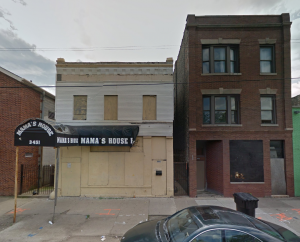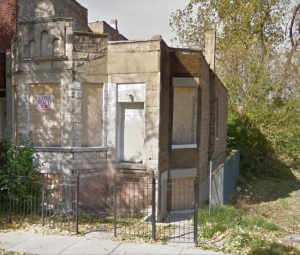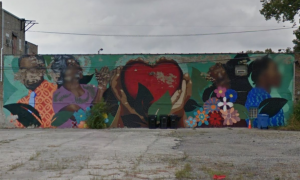| Origins | Annexed in 1869 |
|---|---|
| Area | West Side |
| Boundaries | Railroad tracks on the north, Taylor Street on the south, Tallman Avenue and the railroad tracks on the east, Central Park Avenue on the west |
| Gangs founded | Unknown Vice Lords, |
| Gangs headquartered | Black Souls, Conservative Vice Lords, Unknown Vice Lords, |
East Garfield Park has been a struggling community since the start in 1869. After Chicago annexed this area in 1869 developers struggled to lay out subdivisions in this area and it took until 1905 for any kind of society in this barren part of Chicago to develop. The area was named “East Garfield Park” in 1881 after the assassination of President James A. Garfield.
Starting in 1905 apartment complexes and houses were at last laid out as German and Irish immigrants moved into the area. Many residents took jobs at the Sears Roebuck building that was built in neighboring North Lawndale in 1906. The community struggled with proper planning for public transportation which brought about further disorganization and a lack of further development.
When the great black migration wave began in 1916 East Garfield Park experienced the first black families moving into this community in the 5th City area. These black families were middle class pioneers as they made history as the first black families to move into a white middle class community in Chicago. This was made possible because East Garfield Park was not very well settled by 1916 as real settlement didn’t even begin until 1905 making this area up for grabs for any race to move in. The white community was also accepting because these black families were of the middle class and not part of the struggling lower income classes. Many blacks around Chicago referred to black residents of East Garfield Park as “Well offs.” This was the only part of the city where black middle classes could settle in a white neighborhood for many years to come.
It was not until the 1920s that the neighborhood finally experienced prosperity, and now Italians and Russian Jews began to settle in the neighborhood.
The 1930s would prove to be hard times for East Garfield Park as poverty caused by the Great Depression era caused many homes and apartments to be subdivided into smaller units to house more impoverished families, these buildings were then left to deteriorate, the community also stopped growing.
The 1940s brought some prosperity back to the neighborhood right after World War II as a shopping district was built up in neighboring West Garfield Park neighborhood. The prosperity was not real strong; in fact, the neighborhood still had major issues with poverty and deterioration that never went resolved by the time African Americans and Puerto Ricans began moving in by the early 1950s.







Puerto Ricans settled along the Madison Avenue strip in a small enclave that was an extension of the “La Madison” settlement.
Beginning in 1948, more middle-class blacks ventured into this community, but whites were moving out at the same time allowing this neighborhood to fall victim to redlining practices.
White flight soon took its toll on the neighborhood as many white residents began to experience upward mobility while impoverished African Americans had no such luck and now less tax revenues were coming into the community because lower income residents could not pay those higher tax revenues, this would all lead to disinvestment.
By the year 1958, more African Americans poured into the neighborhood that were displaced from the all over the city due to the various construction projects that forced residents to leave their homes. In exchange for the relocation of the African Americans in the Near West Side the Chicago Housing Authority constructed the Harrison Courts public housing projects bounded by Harrison Street, Congress Parkway, Sacramento Boulevard and Francisco Avenue.
White flight became much more rapid in the late 1950s as black migration took over the old homes and apartments. Landlords took advantage of African Americans by not fixing up the buildings they rented and let them go into horrible states of decay while still charging the same or higher rent.
The 1960s saw the last of white flight in the early to mid-1960s. Since Garfield Park was an impoverished area, there was no desire to fix it up. The neighborhood further fell into urban blights and there was not enough revenue generated by this neighborhood to bring renovations and develop all the empty land.
In the year 1960, the Vice Lords became the first black street gang to settle in this neighborhood. I don’t know when it happened but the original Conservative Vice Lord group eventually became Traveling Vice Lords and/or Unknown Vice Lords. The Black Souls formed on these streets as their motherland in the year 1962. The in the later 1960s the Supreme Gangsters arrive on these streets which would eventually materialize into the Gangster Disciples we know today. Gangster Disciples worked out deals to invite New Breeds to the area as Vice Lords worked with Four Corner Hustlers to bring them to the area. This all occurred in the 1970s and 1980s.
Starting in the later 1960s and especially evolving in the 1970s East Garfield Park became one of the hardest neighborhoods in Chicago with the craziest gang element. The gangs of this neighborhood in the 1970s and 1980s were know for being crazy especially the black Souls. In the 1980s and more so in the 1990s the drug trade became a large part of day-to-day activity on these streets which brought bloody gang wars. The craziness of the 1970s and 1980s combined with the love of money of the 1980s and 1990s created one hell of a gang element on these streets that often is not matched around the city. The intense gang and drug wars continued on until present day.
East Garfield Park still struggles with drugs, crime, vacant lots, deteriorated buildings, and poverty. This neighborhood is also known to be one of the most dangerous neighborhoods in Chicago and often scores on the top 5 or at least top 10 most dangerous Chicago neighborhoods lists over the years. East Garfield Park still struggles with vacant lots and deteriorated conditions.
The dominant groups of East Garfield Park are Black Souls, Gangster Disciples and Traveling Vice Lords. Unknown Vice Lords also exercise a strong presence here.
The significant gangs that have walked these streets over time are:
Black Souls Established 1962-present years
Fulton to Lake, Central Park to Homan (Gangster Black Souls)
Fulton to Lake, Kedzie to Sacramento (New Life Black Souls)
Washington to Madison, Homan to California (Gangster Black Souls and Mad Black Souls) Established 1962
Flournoy to Lexington, Kedzie to Sacramento
5th and Sacramento (Gangster Black Souls, Shared with New Breeds and Gangster Disciples)
Fulton & California (Mad Black Souls)
Walnut & Kedzie ( Mad Black Souls)
Wilcox & Washtenaw (Mad Black Souls)
Arthington & Central Park Ave
5th & Albany
Black P Stones
Lexington & St. Louis
Gangster Disciples
5th Ave and Sacramento (shared with New Breeds and Black Souls)
Jackson & California
Jackson & Sacramento
Maypole & Kedzie
Van Buren & Washtenaw
Wilcox & Francisco
Lake to Washington, Homan to Kedzie (Ike Sims apartments)
Wilcox to Van Buren, California to Rockwell
Maypole to Madison, Western to Hoyne
Albany & Van Buren (Horan Park)
Four Corner Hustlers
Lake to Washington, California to Talman
Madison & Kedzie
New Breeds Established 1992-present years
Congress & Central Park Ave
5th & Sacramento (shared with Black Souls and Gangster Disciples)
Lake & Washtenaw
Madison from California to Washtenaw
Traveling Vice Lords
Madison to Jackson, Rockwell to Campbell partially in Near West Side
Harrison to Lexington, Central Park Ave to Spaulding
Harrison to Flournoy, Sacramento to Francisco (Harrison Courts projects, Harrison Boys)
Harrison to Polk, California to Western
Harrison & Sacramento (Harrison Courts projects, Harrison Boys)
Lexington from California to Francisco (Harrison Courts projects)
Central from Harrison to Congress
Central Park Ave from Harrison to Congress
Albany from Taylor to Harrison
Unknown Vice Lords
5th Ave to Congress, St. Louis to Sacramento (Ghost Town)
Jackson & Central Park Ave
Congress to Monroe, Central Park Ave to Kedzie (Ghost Town)
Jackson & Sacramento
Monroe & Homan
Polk & Kedzie
All images below are photos of vacant buildings. All photos are courtesy of Google Maps.













































